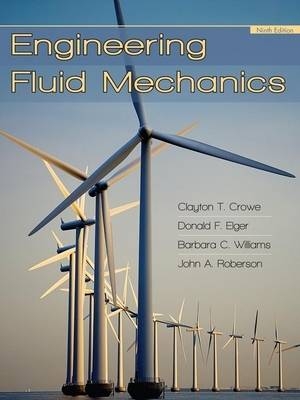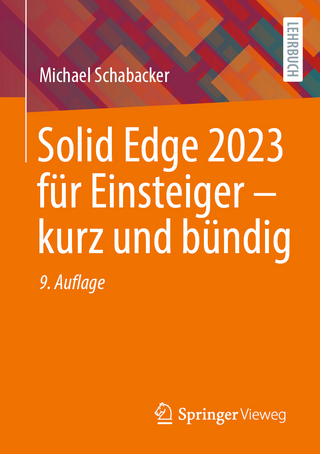
Engineering Fluid Mechanics
John Wiley & Sons Ltd (Verlag)
978-0-470-25977-1 (ISBN)
- Titel erscheint in neuer Auflage
- Artikel merken
Connecting the math and theory of fluid mechanics to practical applications can be a difficult process. Engineering Fluid Mechanics builds on the success of previous editions to help engineers learn how to apply concepts by keeping them engaged and active throughout the book. Simple and effective examples show how key equations are utilized in practice, and step-by-step descriptions provide details into the processes that engineers follow. Each chapter also outlines the three most important things they will be able to accomplish once the concepts are learned. With its physical/visual approach, engineers will quickly gain an intuitive understanding of the principles.
PREFACE. CHAPTER 1 Introduction. 1.1 Liquids and Gases. 1.2 The Continuum Assumption. 1.3 Dimensions, Units, and Resources. 1.4 Topics in Dimensional Analysis. 1.5 Engineering Analysis. 1.6 Applications and Connections. CHAPTER 2 Fluid Properties. 2.1 Properties Involving Mass and Weight. 2.2 Ideal Gas Law. 2.3 Properties Involving Thermal Energy. 2.4 Viscosity. 2.5 Bulk Modulus of Elasticity. 2.6 Surface Tension. 2.7 Vapor Pressure. 2.8 Summary. CHAPTER 3 Fluid Statics. 3.1 Pressure. 3.2 Pressure Variation with Elevation. 3.3 Pressure Measurements. 3.4 Forces on Plane Surfaces (Panels). 3.5 Forces on Curved Surfaces. 3.6 Buoyancy. 3.7 Stability of Immersed and Floating Bodies. 3.8 Summary. CHAPTER 4 Flowing Fluids and Pressure Variation. 4.1 Descriptions of Fluid Motion. 4.2 Acceleration. 4.3 Euler's Equation. 4.4 Pressure Distribution in Rotating Flows. 4.5 The Bernoulli Equation Along a Streamline. 4.6 Rotation and Vorticity. 4.7 The Bernoulli Equation in Irrotational Flow. 4.8 Separation. 4.9 Summary. CHAPTER 5 Control Volume Approach and Continuity Equation. 5.1 Rate of Flow. 5.2 Control Volume Approach. 5.3 Continuity Equation. 5.4 Cavitation. 5.5 Differential Form of the Continuity Equation. 5.6 Summary. CHAPTER 6 Momentum Equation. 6.1 Momentum Equation: Derivation. 6.2 Momentum Equation: Interpretation. 6.3 Common Applications. 6.4 Additional Applications. 6.5 Moment-of-Momentum Equation. 6.6 Navier-Stokes Equation. 6.7 Summary. CHAPTER 7 The Energy Equation. 7.1 Energy, Work, and Power. 7.2 Energy Equation: General Form. 7.3 Energy Equation: Pipe Flow. 7.4 Power Equation. 7.5 Contrasting the Bernoulli Equation and the Energy Equation. 7.6 Transitions. 7.7 Hydraulic and Energy Grade Lines. 7.8 Summary. CHAPTER 8 Dimensional Analysis and Similitude. 8.1 Need for Dimensional Analysis. 8.2 Buckingham Theorem. 8.3 Dimensional Analysis. 8.4 Common-Groups. 8.5 Similitude. 8.6 Model Studies for Flows Without Free-Surface Effects. 8.7 Model-Prototype Performance. 8.8 Approximate Similitude at High Reynolds Numbers. 8.9 Free-Surface Model Studies. 8.10 Summary. CHAPTER 9 Surface Resistance. 9.1 Surface Resistance with Uniform Laminar Flow. 9.2 Qualitative Description of the Boundary Layer. 9.3 Laminar Boundary Layer. 9.4 Boundary Layer Transition. 9.5 Turbulent Boundary Layer. 9.6 Pressure Gradient Effects on Boundary Layers. 9.7 Summary. CHAPTER 10 Flow in Conduits. 10.1 Classifying Flow. 10.2 Specifying Pipe Sizes. 10.3 Pipe Head Loss. 10.4 Stress Distributions in Pipe Flow. 10.5 Laminar Flow in a Round Tube. 10.6 Turbulent Flow and the Moody Diagram. 10.7 Solving Turbulent Flow Problems. 10.8 Combined Head Loss 10.9 Nonround Conduits. 10.10 Pumps and Systems of Pipes. 10.11 Summary. CHAPTER 11 Drag and Lift. 11.1 Relating Lift and Drag to Stress Distributions. 11.2 Calculating Drag Force. 11.3 Drag of Axisymmetric and 3D Bodies. 11.4 Terminal Velocity. 11.5 Vortex Shedding. 11.6 Reducing Drag by Streamlining. 11.7 Drag in Compressible Flow. 11.8 Theory of Lift. 11.9 Lift and Drag on Airfoils. 11.10 Lift and Drag on Road Vehicles. 11.11 Summary. CHAPTER 12 Compressible Flow. 12.1 Wave Propagation in Compressible Fluids. 12.2 Mach Number Relationships. 12.3 Normal Shock Waves. 12.4 Isentropic Compressible Flow Through a Duct with Varying Area. 12.5 Summary. CHAPTER 13 Flow Measurements. 13.1 Measuring Velocity and Pressure 13.2 Measuring Flow Rate (Discharge). 13.3 Measurement in Compressible Flow. 13.4 Accuracy of Measurements. 13.5 Summary. CHAPTER 14 Turbomachinery. 14.1 Propellers. 14.2 Axial-Flow Pumps. 14.3 Radial-Flow Machines. 14.4 Specific Speed. 14.5 Suction Limitations of Pumps. 14.6 Viscous Effects. 14.7 Centrifugal Compressors. 14.8 Turbines. 14.9 Summary. CHAPTER 15 Flow in Open Channels. 15.1 Description of Open-Channel Flow. 15.2 Energy Equation for Steady Open-Channel Flow. 15.3 Steady Uniform Flow. 15.4 Steady Nonuniform Flow. 15.5 Rapidly Varied Flow. 15.6 Hydraulic Jump. 15.7 Gradually Varied Flow. 15.8 Summary. Appendix A-1. Answers A-11. Index I-1.
| Erscheint lt. Verlag | 15.9.2008 |
|---|---|
| Zusatzinfo | ill |
| Verlagsort | Chichester |
| Sprache | englisch |
| Maße | 212 x 262 mm |
| Gewicht | 1170 g |
| Themenwelt | Technik ► Maschinenbau |
| ISBN-10 | 0-470-25977-9 / 0470259779 |
| ISBN-13 | 978-0-470-25977-1 / 9780470259771 |
| Zustand | Neuware |
| Haben Sie eine Frage zum Produkt? |
aus dem Bereich



